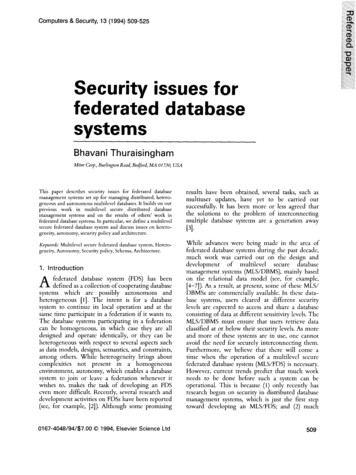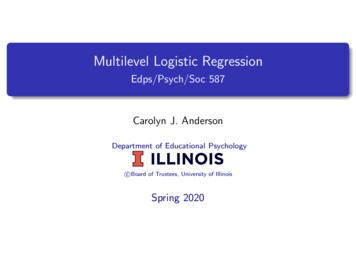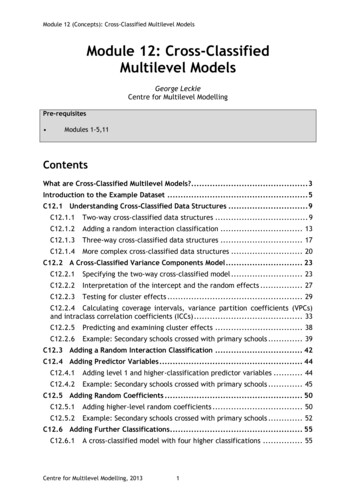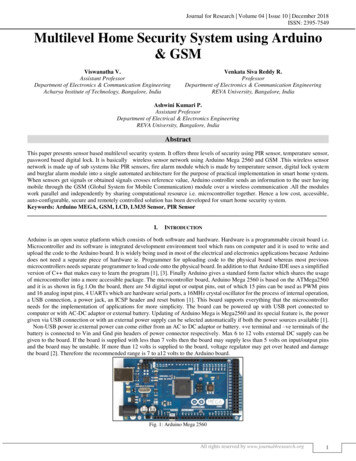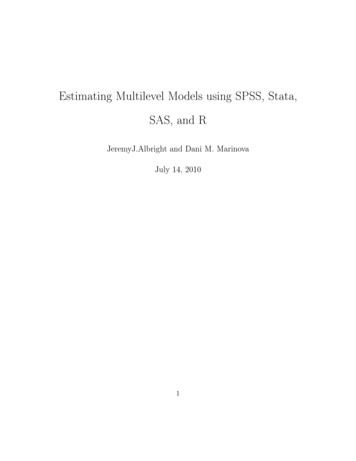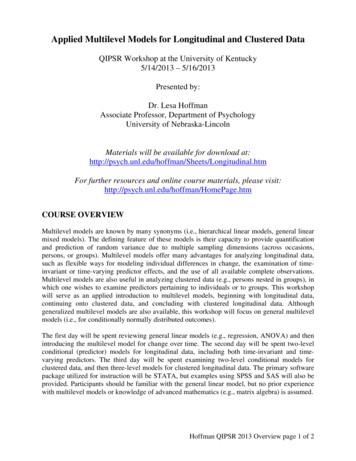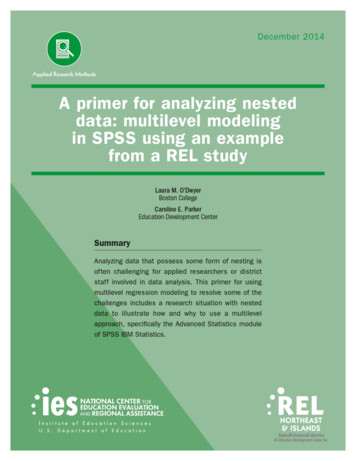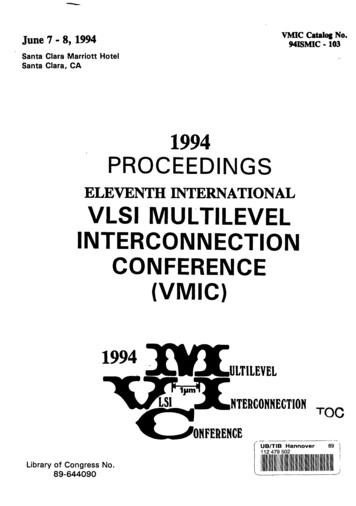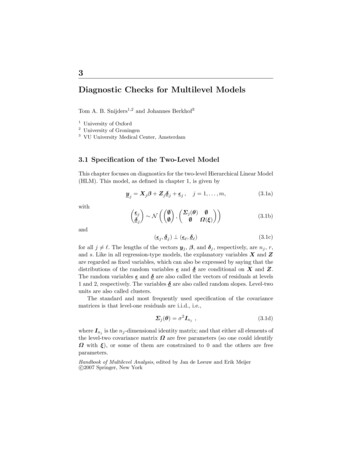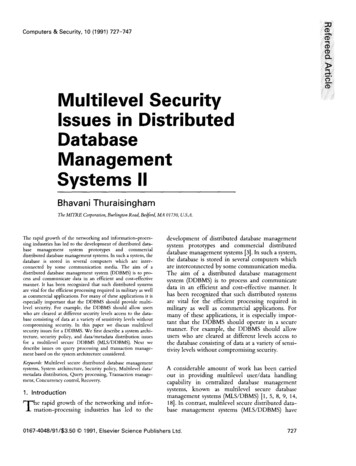
Transcription
Computers & Security, 10 (1991) 727-747Multilevel SecurityIssues in DistributedDatabaseManagementSystems IIBhavani ThuraisinghamThe MITRECorporation, Burlington Road, Bedford, MA 01730, U.S.A.The rapid growth of the networking and information-processing industries has led to the development of distributed datasystembase managementand commercialprototypesdistributed database management systems. In such a system, thedatabase is stored in several computers which are interconnected by some communicationmedia. The aim of adistributed database management system (DDBMS) is to process and communicate data in an efficient and cost-effectivemanner. It has been recognized that such distributed systemsare vital for the efficient processing required in military as wellas commercial applications. For many of these applications it isespecially important that the DDBMS should provide multilevel security. For example, the DDBMS should allow userswho are cleared at different security levels access to the database consisting of data at a variety of sensitivity levels withoutcompromisingsecurity. In this paper we discuss multilevelsecurity issues for a DDBMS. We first describe a system architecture, security policy, and data/metadata distribution issuesfor a multilevel secure DDBMS (MLSJDDBMS).Next wedescribe issues on query processing and transaction management based on the system architecture considered.Keywords: Multilevel secure distributed database managementsystems, System architecture, Security policy, Multilevel data/metadata distribution, Query processing, Transaction management, Concurrency control, Recovery.1.IntroductionThe rapid growth of the networking and information-processingindustries has led to the0167-4048/91/ 3.50development of distributed database managementsystem prototypes and commercialdistributeddatabase management systems [3]. In such a system,the database is stored in several computers whichare interconnected by some communication media.The aim of a distributed database managementsystem (DDBMS) is to process and communicatedata in an efficient and cost-effective manner. Ithas been recognized that such distributed systemsare vital for the efficient processing required inmilitary as well as commercial applications. Formany of these applications, it is especially important that the DDBMS should operate in a securemanner. For example, the DDBMS should allowusers who are cleared at different levels access tothe database consisting of data at a variety of sensitivity levels without compromising security.A considerable amount of work has been carriedout in providing multilevel user/data handlingcapability in centralized database managementsystems, known as multilevelsecure databasemanagement systems (MIS/DBMS)[l, 5, 8, 9, 14,181. In contrast, multilevel secure distributed database management systems (MIS/DDBMS)have0 1991, Elsevier Science Publishers Ltd.727
B. ThuraisinghamlMultilevelSecurity in Database ManagementIFront-endFig. 1. An architecturereceived very little attention.’ Note that in someDDBMSs limited forms of discretionary securitycontrols (that is, where users access data based onauthorizations) do exist [3].In an earlier article published in this journal [ 1 l],our preliminaryinvestigationonmultilevel security issues for a distributed databasemanagement system. The architecture that we considered was the front-end/back-endtype illustrated in Fig. I. This architecturewas chosensimply because it was the one example of a distributcd architecture considered in the Air ForceSummer Study [l]. In this architecture, a front-endmachine is connected to one or more back-enddatabase systems. All requests to the databasesystems arc via the front-end machine. That is, thefront-end machine controls the execution of alltransactions. As a result the back-end machinescannot execute local applications. This feature isnot strictly in accordance with the standard definition of a DDBMS given in Ceri and Pelagatti [3], inwhich it was stated that:WC described“A distributed database is a collection of data whichis distributed over agerent computers of a computernetwork. Each site of the network has autonomousprocessing capability and can perform local applications. Each site also participates in the execution of‘An MLS/DBMSis also called a trusted database managerncntsystem (TDBMS). Similarly, an MLS/DDHMSis also calledtrusted distributeddatabase managementsystem (TDDRMS).728aS ys ternsIfor a DDBMS.at least one global application, which requiresaccessing data at several sites using a communicationsubsystem. A distributed database managementsystem supports the creation and maintenance of adistributed database.”In contrast to Fig. 1, Fig. 2 illustrates an architecturc that conforms to this definition of a DDBMS.It is this architecture that is being considered inmany DDBMS prototypes and products [12]. Inthis architecture, the nodes arc connected via acommunicationsubsystem. This subsystem couldbe any network such as a local area network or along-haul network. Each node has its own localDBMS which is capable of handling the localapplications. In addition, each node is also involvedin at least one global application. In other words,there is no centralized control in this architecture.In this paper multilevel security issues for aDDBMSbased on such an architecturearedescribed. It is primarily these issues that have to beconsidered in the design of any MLUDDBMS.Each of the issues considered in this paper is brieflyintroduced below.(1) System architecture: we will illustrate a systemarchitecture for an MLVDDBMSwhich has beenderived from our choice of architecturefor aDDBMS (given in Fig. 2). All of the security issuesto be described in this paper will be based on thissystem architecture.
Computers and Security, Vol. 70, No. 8Communication NetworkFig. 2. Choice architecture for a DDRMS(2) Security policy: we will discuss some issues fora mandatory security policy for an MLYDDBMS.a distributed transaction manager as well as secureconcurrency control techniques will be discussed.(3) Multilevel dat a/metadata distribution: there aretwo types of data distribution schemes that shouldbe considered in an MLYDDBMS.One is the distribution of multilevel data within a node and theother is the distribution of multilevel data acrossnodes. Both distribution schemes will be discussed.Mctadata describes the data in the distributed database. Metadata could also be assigned differentsecurity levels. The issues involved in secure metadata management are the design of the meta-database and the distribution of the metadata.The or anization of this paper is as follows: section2 will dgescribe the system architecture that we haveconsidered for an MLVDDBMS.Mandatory security policy issues will be discussed in section 3. Multilevel data/metadata distribution issues will bcdiscussed in section 4. Query processing in anMLS/DDBMSwill be discussed in section 5.Transaction management in a multilevel cnvironment will bc discussed in section 6. The paper willbe concluded in section 7.(4) Query processing: query processing is one ofthe more important functions of an MLVDDBMS.The techniques should ensure that users obtain thedata at or below their security level. The data distribution issues should be transparent to the user.An architecture for a distributed query processor aswell as strategies for secure query processing willbe discussed.(5) Transaction management: a transaction in amultilevel environment executes at a particularsecurity level. The issues involved in transactionmanagement in an MLS/DDBMS are secure concurrency control and recovery. An architecture forWe assume that the reader is familiar with concepts in DDBMS and MLVDBMS.An excellentdiscussion on DDBMS concepts is given in Ceriand Pclagatti [3]. A useful starting point forconcepts in MLYDBMSis the Air Force SummerStudy Report [ 11.2. SystemArchitectureIn an MLYDDBMS,users cleared at differentsecurity levels access and share a distributed database consisting of data at different security levelswithout violating security. The system architecturefor an MLVDDBMSthat we consider in ourinvestigation is shown in Fig. 3. This architecmrc729
B. y in Database Management fMultilevelDatabase‘\ fMultilevel DatabaseS ys terns3IIMultilevel (Trusted) Communication NetworkFig. 3. System architecturehas been derived from our choice of architecturefor a DDBMS (given in Fig. 2). All of the securityissues to be described in this paper will be based onthis system architecture.In this architecture, the MLVDDBMSconsists ofseveral nodes that are interconnected by a multilevel secure network.2 We assume that the nodesare homogeneous. That is, all of the nodes arcdesigned identically. Each node is capable of handling multilevel data. Each node has an MLS/DBMSwhichmanagesthe localmultileveldatabase. Each node also has a distributed processing component called the secure distributed processor (SDP).3 The components of SDP, shown inFig. 4, are the distributed metadata manager(DMM), distributed query processor (DQP), distributed transaction manager (DTM), and the distributedconstraint(DCP).“DMMprocessormanages the global metadata. The global metadataincludeinformationon the schemata whichdescribe the relation9 in the distributed database,ZA multilevel secure network is also called a trusted network.Issues are discussed in Trusted Network Interpretation [I 71.3This paper will discuss mainly the issues involved in designingthe SDP.4DQP and DTM will be described in sections 5 and 6 respectively. DMM will be briefly described in section 4. DCP will bedescribed in a forthcoming paper.‘WC assume that the database is relational. Multilevel data distribution issues will be discussed in section 4.730for a MLVDDBMS.the way the relations are fragmented, and the locations of the fragments.‘j DQP is responsible for distributed query processing. DTM is responsible le for handling security constraints duringquery and update processing?The DQP and DTM communicate with the DMMfor the metadata required to carry out their functions. In our desi n of the SDP we do not have aseparate module sor update processing. We assumethat individual update requests are handled by theDQP.s Update requests specified as part of a transaction are handled by the DTM. Since a transactionis a series of query and update requests, we assumethat the DQP is invoked by the DTM in order tocarry out the individual requests. Two DMMs (orDQPs, DTMs) at different nodes communicate inaccordance with the security policy enforced. SDPmay be implemented as a set of processes separatefrom the local MLVDBMS.6Note that informationpertaining to the local database ismanaged by the local MLVDBMS.7Security constraints are rules which assign security levels tothe data. For a discussion we refer to Dwyer et al. [6].RThe update operation performed by the DQP is straightforward. A user at level L updates data at level L. In our designof the DQP we have only concentrated on the query operation.
Computers and Security, Vol. 10, No. essorDistributedConstraint MetdataManagerFig. 4. Secure distributed3. SecurityPolicyThe security policy for a computing system consistsof a set of policies for mandatory security, discretionary security, integrity and authentication,among others. Our focus is on a mandatory security policy for an MLYDDBMS.An effectivemandatory security policy for an MLS/DDBMSshould ensure that users only acquire the information at or below their level.’ The basic mandatorysecurity policy for the MLVDDBMSthat we haveconsidered has the following properties.Subjects are the active entities (such as processes) and objects are the passive entities (such astuples or relations).(1)(2) Subjects and objects are assigned security levels.The set of security levels forms a partially orderedlattice (e.g., unclassified confidential secret topsecret).‘By a securitypolicy we will mean a mandatorysecuritypolicy.processor.(3) A subject has read access to an object if the subject’s security level dominates the security level ofthe object.(4) A subject has write access to an objectsubject’s security level is the security levelobject. (Note that this is a restricted version*-property of the Bell and LaPadula securityif theof theof thepolicy[21.(5) A subject Sl can send a message to anothersubject S2 if the security level of S2 dominates (i.e.greater than or equal to) the level of S 1.In designing a secure system, it may be necessaryfor additional security policy extensions to beenforced. Such policy extensions arc carried out bytrusted subjects. lo That is, it has to be ensured thatsuch a subject’s security critical functions arc‘OSee the designand Thuraisinghamextensions.ofthe[14]h4LS/DBMSfor a discussiongivenin Stachouron security policy731
B. ThuraisinghamllVultilevelSecurity in Database ManagementFig. 5. Security architecturecarried out correctly. In addition, any subject that isprivileged to violate the security policy must alsobe trusted. For example, if a message has to be sentfrom a sccrct subject to an unclassified subject,then the secret subject must bc trusted.The security architecture that we consider is shownin Fig. 5. WC assume that each node has a trustedcomputing base (TCB). The TCB is the part of thehost that enforces the mandatory security policy atthat host. The network TCB is responsible forenforcing the network security policy. The TCBhosts various trusted applications such as an MLS/DBMS and an SDP. Additional security policyextensions may be enforced by these applicationsdepending on their designs. In our design, thesystem must ensure that two DMMs (DQPs,DTMs, DCPs) at different nodes can communicatewith each other only if they both operate at thesame level. Also, additional security policy cxtensions are enforced by certain modules of the SDP.Note that in our discussion of security issues for aDDBMS, we do not refer to the level of assuranceprovided by the system. The levels of assuranceprovided by computing systems arc discussed inthe Trusted Computer Systems Evaluation Criteria[15]. An intcrprctationof the TCSEC for multilcvel database systems is given in Trusted Database Interpretation [I”]. It appears that criteria forevaluating MLS/DDBMSs will not be available inthe near future. The assurance provided by the732Systemsfor an MLVDDBMS.MLVDDBMSwill depend on the assurance provided by the local hosts and the network.” Theassurance provided by the network is determinedby the interpretation of the TCSEC for networksgiven in Trusted Network Interpretation [ 171.4.MultilevelData/MetadataDistributionThe functions of the SDP will depend on the waythe data are distributed. In this section we dcscribcmultilevel data/metadata distribution issues. Wefirst discuss data-modellingissues and thendescribe how data and metadata may be distributedwithin and across sites.Local Data DistributionWe assume that the database is based on the rclational model12 at the global and local levels. Therefore, the data model used to represent the databaseat the global and local levels is a multilevel relational data model. In this section we define a multilevel relational data model that is used torepresent the multilevel database at each localnode. A multilevel relational data model is the rela4.1.“For example, the security policies of the local operating system, local MLS/DBMS, SDP, and the network have to be integrated in order to obtaina securitypolicyfor theMLS/DDHMS. It should be noted that very little work has beendone on integrating the security policies of different modules.lZThe relational data model was initially developed by Codd[“l.
Computers and Security, Vol. 70, No. 03040708060LevelUuuSssFig. 6. Multilevel relation.tional data model extended with constructs to support multilevel security.A multilevel relational database consists of a set ofmultilevel relations. We define a multilevel relation to be a relation in which each tuple is assigneda security level. Figure 6 shows a multilevel relationEMP. Note that the tuples in EMP are either secretor unclassified. Furthermore, if SS # is taken to bethe primary key of EMP, then we see that there aretwo tuples with the same primary key at differentsecurity levels. This feature is known as po&nstuntiation [ 141. In other words, we assume that SS #together with the security level forms the primarykey for the relation EMP.Recombination is the process of forming a view ofa relation at a particular security level. The recombination operation at a security level L will involveall tuples of the relation dominated by L. Whenpolyinstantiation is present, a user can request thelower-level polyinstantiated tuples to be removedfrom his view. If so, only the tuple associated withthe maximum security level that is dominated bythe security level at which the recombinationoperation is being performed is considered. Figure7 illustrates the various views of the multilevelrelation EMP that the unclassified and secret usershave.At the physical level, the multilevel-relationEMPcould be stored in single-level fragments. Figure 8EMP-UEMP-SUnclassified RelationSecret RelationFig. 8. Single-level relations.WSS#UnclassifiedViewSecret View Unclassified PolyinstantiatedTuples s604Mary80Secret View Unclassified PolyinstantiatedTuples Not RemovedFig. 7. Views at different security levels.733
B. ThuraisinghamlMultilevelSecurity in Database Managementillustrates this feature. The fragment EMP-U storesthe unclassified tuples of EMP and the fragmentEMP-S stores the secret tuples of EMP.We assume that the security level of the schema ofa relation is the security level of the user whocreates the schema. For every security level L thatdominates the security level of the schema of arelation R, there could be tuples of R at level L.Therefore, corresponding to an unclassified schemaof relation R, there could be tuples of R at theunclassified, confidential,secret, and top secretSite 1: EMP-USite 2: EMP-S21IFig. Y. Multilevellevels. Since a multilevel relation can be decomposed into single-level relations, corresponding toevery security level L that dominates the securitylevel of the schema of a relation R, there could befragments of R at level L. A user can read any tuplewhose security level is dominated by his level.When a user enters a tuplc, the tuplc is assignedthe level of the user and is stored in a fragment ofthe relation at the security level of the user. If theuser’s security level is dominated by the securitylevel of the schema of the relation, then the tuple isnot entered.4.2. Distribution Across SitesAs stated before, we assume that the global datamodel is the same multilevel relational model usedto represent the local databases. The global multilevel relations could be totally or partially replicated across sites. Furthermore, the relations couldalso be horizontally fragmented. That is, the globalrelation is partitioned into horizontal subsets. Thesubsets could be stored across several sites. Tuplescould be polyinstantiated within as well as acrosssites. A multilevel distributed database stored attwo sites is illustrated in Fig. 9. Figure 10 illustratesthe global views that the unclassified and secretusers have of the database.Site 1: EMP-SSite 2: EMP-USystemsDavidSmithdistributed database1SS#::61 yJillSmithUnclassified ViewSecret View Lower LevelPolyinstantiatedTuplcs RcmovcdFig.734IO. Global et View Lower LevelPolyinstantiatedTuples Not Removed1
Computers and Security, Vol. 70, No. 8Node 2Node 1Read/WriteUnclassifiedFig. 11. Multilevel metadata.A Note on Metadata ManagementMetadata at the global level are managed by thedistributedmetadatamanager(DMM).i3Themetadata at the global level include information onthe schemata of the global relations, the way therelations are fragmented, the allocation of the fragments, and the various constraints enforced. Weassume that the metadata are replicated at eachnode. Furthermore, we assume that metadata arestored at multiple security levels. Metadata storedat level L are also classified at level L. There is amanager at each security level. The managers neednot be trusted in the distributed architecture thatwe have considered.14 The manager at level Lmanages the metadata at level L. The manager at asecurity level L in node 1 communicates with themanager at security level L in node 2 in order toaccess remote metadata. Such a scheme is illustrated in Fig. 11.4.3.5. DistributedQuery ProcessingIn secion 5.1 we describe an architecture for theDQP and in section 5.2 we discuss soris responsiblefor processing“Note that the DMM is part of the SDP described in section 2.14Note that we are concerned with secrecy issues only. That is,we do not address integrity issues in this paper.queries is the distributed query processor (DQP).”The components of the DQP, shown in Fig. 12, arethe user interface manager (UIM), query transformer (QT), the query optimizer (QO), and the distributed execution monitor (DEM). The user’squery is parsed by the UIM. The QT transformsthe parsed query at the logical level. That is, thequery transformation process transforms a globalquery into equivalent fragment queries. This process is performed according to transformation rulesand does not depend on the allocation of the fragments. Discretionary access checks are also performed by the QT. The transformed query is thenprocessed by the QO, which determines the mostefficient way to execute the query. That is, thealternate execution strategies produced by the QTmust be examined by the QO in terms of the costof executing them. The cost is usually determinedby the number of tuples that are transmitted andthe number of operations that have to be performed. The DEM monitors the execution of thequery. The DEM interfaces to the local ML9DBMS.16 The metadata required for distributed‘sNote that the DQP is part of the SDP described in section 2.161n a heterogeneous environment, there will be a local execution monitor (LEM) which will be responsible for the necessarytransformation between the global representation and localrepresentation. The DEM will have an interface to LEM andLEM will have an interface to the local MLYDBMS.735
B. ThuraisinghamlMultilevelSecurity in Database ManagementNetworkInterfaceS ocal Multilevelmi%D:MSFig. 12. Distributedquery processing arc obtained from the distributedmctadata manager (DMM). Communication with aremote DQP is achicvcd via the Network InterfaceManager.The DQP could be implcmcntcd using the processmodel or the client-server model. In the processmodel, there is a DQP process for each user. Thisprocess executes at the same level as the user. In theclient server model there is a set of DQP proccsscsper security level. A DQP process executing at lcvclL services rcqucsts of users at level L. The systemmust ensure that two DQPs at different nodescommunicate only if they both opcratc at the samelcvcl. The DQP operating at level L communicateswith the DMM process also operating at level L inorder to obtain the necessary metadata. A user’srequest at level L will be processed cntircly at levelL. As a result, information which is not dominatedby level L will not b e used during the processing.Thercforc, no additional security policy extensionsare enforced by the DQP. That is, the DQP neednot be a trusted process.736i z-quc’y’processor.5.2. StrategiesIn this section, we describe two query-processingstrategies for the join operation.” WC consider thejoin operation as it is one of the most time-consuming operations and it has been studied extcnsively in the past for non-multilevel DDBMSs [3].WC describe the strategies for a join operationinvolving only two relations.Let EMP and DEPT be two relations. EMP hasattributes SS # , Name, Salary and D # with SS # asthe primary key. DEPT has attributes D # , Dnamc,and Mgr with D # as the primary key. We assumethat tuples have different security levels. A tuple atlcvcl L is stored in a fragment of the relation atlevel L. That is, the secret tuplcs arc stored in asecret fragment and the unclassified tuplcs arcstored in an unclassiflcd fragment. The fragmentscould also bc partitioned horizontally. Furthcr“We have madescntcd hcrc. Thewhere.several optimizationsoptimizedstratcgicsco the strategieswill be describedpreelsc-
Computers and Security, Vol. 70, No. 8more, tuples could also be polyinstantiated. Suppose the query is to form the join between EMPand DEPT over the D # values. Let us also assumethat the user requests the lower level polyinstantiated tuples not to be involved in the join operation. We call such a join the restricted join. Weassume that polyinstantiationwithin a node ishandled by the local MLVDBMS.Therefore, weare only concerned with the polyinstantiated mplesacross sites.In the first strategy, called the nondistributed join,the fragments of each relation at or below theuser’s level are mer ed first, then the lower-levelpolyinstantiated tup f;es are eliminated, and finallythe joinoperationis performed.A possiblesequence of operations for the nondistributed joinis as follows:(1) Find the sites A and B which have the mostnumber of tuples of the relations EMP and DEPT,respectively, provided the tuples are at or below theuser’s level.(2) Send all EMP fra ments at or below the user’slevel to site A and aK1 the DEPT fragments at or18below the user’s level to site B.(3) Form the union of the EMP fragments el polyinstantiated tuples. Let the resulting EMP and DEPT relations be EMP* and DEPT*respectively.Figure 13( a) sh ows a multilevel distributed database stored at two sites. Site 1 has the unclassifiedEMP fragment EMP 1-U and the secret DEPT fragment DEPT 1 -S. Site 2 has the secret EMP fragmentEMP2-Sand the unclassified DEPT fragmentDEPT2-U.Suppose a secret user requests a restricted join between EMP and DEPT. We willdescribe how this join operation will be carried outusing the strategy described above. Step (1) of thestrategy will select site 1 as the site for the mergeoperation for both relations. Step (2) of the strategywill send both the fragments at site 2 to site 1.Figure 13(b) illustrates the relations EMP* andDEPT* obtained as a result of step (3). Since bothrelations are at site 1, steps (4) and (5) are not neccssary. Figure 13(c) shows the result of the joinoperation which is obtained as a result of step (6).In the second strategy, called the distributed join,the join operations are performed between variousfragments. Finally, the results of the individual joinoperations are merged. A possible sequence ofoperations for the distributed join is as follows:(1) Determine whether it is less costly to send (I)all the DEPT fragments at or below the user’s levelto each site with an EMP fragment at or below theuser’s level or (2) all the EMP fragments at or belowthe user’s level to each site with a DEPT fragmentat or below the user’s level. Let us assume that it isless costly to do (1).Send the(2) Send each DEPT fragment at or below theuser’s level to any site which has an EMP fragmentat or below the user’s level.(5) Reduce the relation DEPT* using the D#values received. That is, perform the join betweenthe D# values received and the relation DEPT*.Let DEPT** be the reduced relation.(3) When the DEPT fragments are received at asite, perform the union of these fragments and theneliminate the lower-level polyinstantiated tuples.Let the result be DEm*.(6) Send DEpT** to node A. Perform the joinbetween EMP* and DEPT**. Send the result to thesite at which the query was posed.(4) Perform the join operation between DEPT*and the fragment of EMP at or below the user’slevel at that site. If there are more than two fragments of EMP at or below the user’s level, thesefragments are merged first before performing the(4) Project the relation EMP*D # values to node B.“Noteon D#.that A and B may be the same node.737
B. ThuraisinghamlMultilevelSecurity in Database ManagementSITE alary203040506070D#f::;:1020SITE 2EMPZSDEPT2-Um1 201 Physics 1 b)RESULTSS# :345678NameJohnPaulJamesI *DavidPeterFig. 13. Example illustrating strategy7381.Systems
Computers and Security, Vol. 10, No. 8join operation. Note that lower-level polyinstantiated tuples are removed during the merge operation. Let R,, R,, . . . . R, be the result of the joinoperation at the various sites. For each SS# valuesoccurring in Ri (1 G i G n), attach its security levelalso. This security level is the level of the corresponding EMP tuple used in the join operation.(5) Transmit all the relations R,, R,, . . . , R, to aselected site. This site is dctcrmincd by computingthe costs to transmit the tuples to the various sitesand selecting the one with the least cost.(6) Merge R,, R,, . . . . R,. Let the result be R.Eliminate from R all lower-level tuples with polyinstantiated SS# values. The result is sent to thesite at which the query was posed.Figure 14(a) shows the same distributed database ofFig. 13(a). Supp ose a secret user requests a restrictedjoin between EMP and DEPT. We will describehow the join operation will be carried out usingthe second strategy described above. In step (1) itwill be determinedthat the DEPT fragmentssho
distributed database management systems. In such a system, the database is stored in several computers which are inter- connected by some communication media. The aim of a distributed database management system (DDBMS) is to pro- cess and communicate data in an efficient and cost-effective manner.
